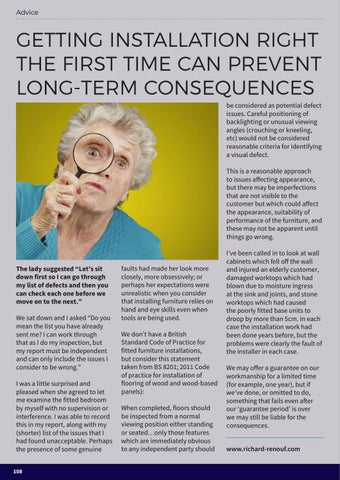Advice
GETTING INSTALLATION RIGHT THE FIRST TIME CAN PREVENT LONG-TERM CONSEQUENCES be considered as potential defect issues. Careful positioning of backlighting or unusual viewing angles (crouching or kneeling, etc) would not be considered reasonable criteria for identifying a visual defect. This is a reasonable approach to issues affecting appearance, but there may be imperfections that are not visible to the customer but which could affect the appearance, suitability of performance of the furniture, and these may not be apparent until things go wrong.
The lady suggested “Let’s sit down first so I can go through my list of defects and then you can check each one before we move on to the next.” We sat down and I asked “Do you mean the list you have already sent me? I can work through that as I do my inspection, but my report must be independent and can only include the issues I consider to be wrong.” I was a little surprised and pleased when she agreed to let me examine the fitted bedroom by myself with no supervision or interference. I was able to record this in my report, along with my (shorter) list of the issues that I had found unacceptable. Perhaps the presence of some genuine 108
faults had made her look more closely, more obsessively; or perhaps her expectations were unrealistic when you consider that installing furniture relies on hand and eye skills even when tools are being used. We don’t have a British Standard Code of Practice for fitted furniture installations, but consider this statement taken from BS 8201; 2011 Code of practice for installation of flooring of wood and wood-based panels): When completed, floors should be inspected from a normal viewing position either standing or seated…only those features which are immediately obvious to any independent party should
I’ve been called in to look at wall cabinets which fell off the wall and injured an elderly customer, damaged worktops which had blown due to moisture ingress at the sink and joints, and stone worktops which had caused the poorly fitted base units to droop by more than 5cm. In each case the installation work had been done years before, but the problems were clearly the fault of the installer in each case. We may offer a guarantee on our workmanship for a limited time (for example, one year), but if we’ve done, or omitted to do, something that fails even after our ‘guarantee period’ is over we may still be liable for the consequences. www.richard-renouf.com
































